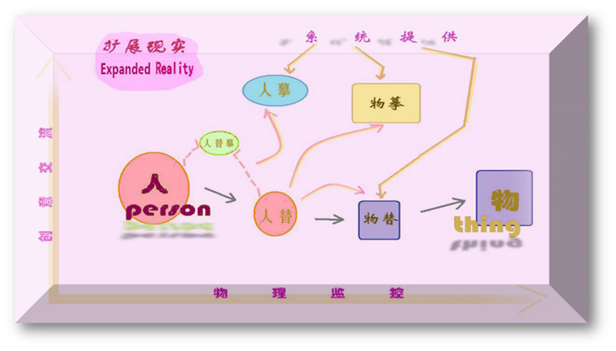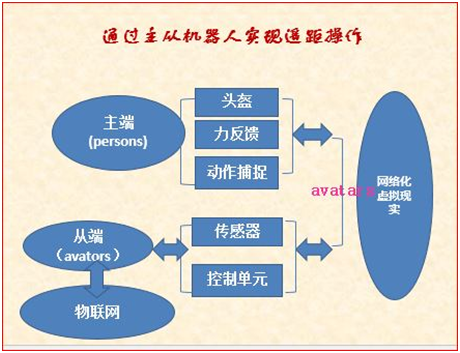Remote operation in 5G and VR--Dr. Zhenming Zhai
2020-12-16
An overview,
This article covers four key words. This is the Internet of Things, remote operations, master-slave robotics, 5G communications. So let's define it.
• The First is the Internet of Things (IoT) : The Internet of Things (IoT) is the systematic identification and connection of electronic information between man-made and even natural objects and the Internet at the same time.
• The second is Teleoperation: Teleoperation is the manipulation of physical processes from distant locations with the help of remote proximity technology and corresponding hardware facilities, and the operator perceiving them as field operations.
• Master/Slave Robot: The concept of Master/Slave Robot is a Robot that repeats human actions with minimal delay. This Robot is an unintelligent Robot (human Avator).
• 5G Commnication: The fifth generation of wireless communications.
With these four definitions, we can look at how they relate, when combined with virtual reality, to what an extended reality, ER, looks like.
2. Internet of Things plus Virtual Reality and its expansion
As the Internet terminal of the operation interface of logistics control system, the Internet of Things is discrete if it is not integrated with the virtual world. Virtual reality links these separate interfaces together, and the individuals involved form a consortium that monitors the connected Internet of Things. In this way, the virtual Reality is extended it (Expanded Reality), the consortium created a virtual world, in this virtual Reality will become a virtual world) and the experience of the world is not just communication, but also the practice of the manipulation of the natural process of causal space, that is, they work for the survival and development, is a new habitat.
One thing to note here is that extended reality is a newly created concept, which can also be called reverse augmented reality, because it is based on virtual reality as the main environment. Assuming that we want to live in this world, but do not come out, what elements of physical reality do we need to integrate into it? This is the only form of augmented reality that seems to have been reversed. Imagine that the interface of the Internet of Things must be replaced by the intuitive interface of virtual reality. With virtual reality, who will still search, search engine mode will be replaced by sensory response mode. ?
With the concept of extended reality in mind, let's take a look at what exists.
Third, expand the categories of existence in reality (ER)
There are five kinds of beings:
1) Avatar, a sense complex directly controlled by the user in real time, coincides with the visual image of the physical body in space under a complete immersion environment, transforming from the objective representation of the third person into the main representation of the audio-visual field center of the first person.
2) Human replicators (NPCS), artificial intelligence-driven facsimiles, can be created by the system or by users.
3) Physicum, a sensory complex corresponding to the telepresence of objects in the Internet of Things.
(4) Physicon, the various "objects" in the world that are not given the meaning of life.
5) Avatar Agent, an artificial intelligence-driven avatar agent dispatched by the user to pretend to be a real person when the user is off line.
In addition, considering the addition of animal groups in the future, we will also have:
Animal Avatars, if the signal input side uses the full sensing technology for real-time dynamic capture instead of the keyboard and mouse, we can allow the user's pet or other animals into the virtual world, so that there will be such objects active in the world.
7) Animal Agent, a simulated animal driven by artificial intelligence, such as a pet dog in the virtual world of Second Life.
In this way, the seven kinds of existence are expanded. By some standards, this exhausts all the possibilities of existence.
Kinds of existence in Expanded Reality
For brevity, we can leave out the animals and have the following extended reality structure (the dark arrow at the bottom represents the path through which the user performs the remote operation, and the other directed lines represent the relationship between creation and creation. The human body is in addition to ER, in the "object" on the far right.)

This schematic diagram of extended reality lists the existences (except animals) in the virtual world. Beginning with people, wearing a helmet, there will be replacements. The difference from human substitution is human copy, which is provided by the system, and does not correspond to a fake person with a real person. There are also animal substitutes and animal copies not drawn. The more interesting thing is the human-replacement g, which is when you are not online, you have to pretend to be online and send a fake you driven by artificial intelligence to interact with people in the environment. We also need to control the Internet of Things, which requires replacement of things, which corresponds to the non-intelligent robots in the Internet of Things. In addition, there are facsimiles of objects provided by the system or created by users, such as natural objects or artificial objects of mountains, waters and lakes in the game. Here, everyone must pay attention to the three arrows from left to right below, which must be from person to object, not from object to person. But people's natural tendency is just the opposite, from things to people. Things are regarded as "serious applications", and the virtual world is regarded as a place to play, a place where "non-serious applications" degenerate. This idea is quite dangerous. In fact, on the contrary, the place where the person is is the purpose, and the Internet of Things is a tool, which must not be reversed.
Let's take a look at the interactive relationship between the various parts of the extended reality, take a look at their respective functions in general, and see how the remote operation is achieved:
Starting from the main end, that is, starting from individual people, put on a helmet, which has a gyroscope, accelerometer and other small instruments. Through 3D modeling, there is an avatar in the virtual world. Note that this is a networked virtual reality, also called a virtual world.
Looking back, I receive force feedback on my hand and produce a sense of touch. Conversely, the master applies a signal to the slave, so that the avator on the slave repeats the actions of people. In the Internet of Things, the avator is replaced by the avator. The world becomes a manipulated world. Various sensors and manipulators will play an important role here.
From this picture we can see the whole process of remote operation. But the perfect realization of this process depends on smooth communication technology to achieve high-definition without delay, which depends on 5G communication technology as the foundation.
4. Opportunities created by 5G
We know that Huawei is one of the world's two major 5G suppliers, and the other is Qualcomm. According to Huawei,

5G mainly serves the Internet of Things. So, first of all,
5G provides a foundation for the comprehensive popularization of the Internet of Things;
Secondly, the extremely high transmission rate of 5G provides conditions for the perfect operation of master-slave robots, thereby providing a communication method with almost no delay for remote operation;
Thirdly, 5G provides guarantee for the quality of cloud services, enabling remote operation to be one-to-many globally, switching at any time.
In this way, the application of 5G has laid the foundation for the large-scale popularization of the virtual world of VR. The popularization of ER can be achieved without relying on killer applications.
